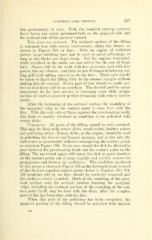Page 619 - My FlipBook
P. 619
FINISHING GOLD FILLINGS. 297
this particularly in view. With the rounded cutting surfaces
these forms are easily produced both on the gingival side and
the occlusal side of the point of contact.
The occlusal surface. The occlusal surface of the tilling
is trimmed best with rotary instruments, either the stones, as
shown in Figure 1589, or burs. With an engine of sufficient
power, large finishing burs can be used to great advantage so
long as the blades are kept sharp. But the engines furnished,
while excellent in the main, are not suited for the use of large
burs. Stones will do the work with less pressure, and with less
power, but are slower ; and they do not distinguish between cut-
ting gold and cutting enamel as do the burs. Much care should
be taken to finish the filling fully to the euamel margin without
cutting into the enamel. Every part of this should be made per-
fect so that there will be no overlaps. The discoid and the spoon
excavators do the best service in trimming when little irregu-
larities of surface prevent perfect trimming with rotary instru-
ments.
After the trimming of the occlusal surface the rounding of
the marginal ridge to the contact point is done best with the
files. With the safe side of these against the proximating tooth,
this form is readily obtained in condition to be polished with
rotary disks.
Polishing. All parts of the filling should be well polished.
This may be done with rotary disks, wood points, leather points
and polishing strips. Rotary disks, in the engine, should be used
in polishing the buccal and lingual margins and as far into the
embrasure as practicable without endangering the contact point,
as shown in Figure 390. In no case should the disk be allowed to
pass between the proximating tooth and the contact point on the
filling. The narrowed space will cause the disk to press hardest
on the contact point, cut it away rajjidly and quickly remove its
prominence and destroy its usefulness. The condition produced-
by this error is shown in Figure 395 in the flattened plane instead
of the desired rounded contact point shown in Figures 393. 394.
All scratches left by the files should be perfectly removed and
the surfaces evenly rounded. Much of the rounding of the prox-
imal surface onto the occlusal surface forming the marginal
ridge, including the occlusal portion of the rounding of the con-
tact point itself, may be done with the disks, after the rougher
part of this has been done with the files.
Wlien this part of the polishing has been completed, the
gingival portion of the filling should be polished with narrow
lOa


